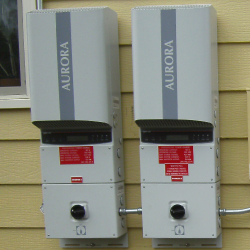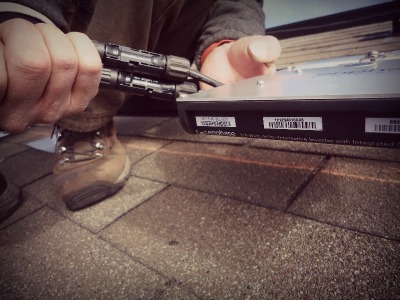
Laptop Sized Solar Inverters a Reality?
scott | Sunday, March 1st, 2015 | 3 comments
Google and the IEEE Power Electronics Society has introduced an open competition to build a small power inverter, known as the Little Box Challenge. The winner of the $1 million prize will have designed and built a smaller, cheaper, and more efficient kilowatt-scale inverter with a power density of at least 50 Watts per cubic inch.
OK, But What's a Inverter?
 Inverters are the device that convert (invert) the DC power from solar arrays (among other sources) into the AC power used by your home or business. Solar inverters are currently the size of "picnic coolers". This bulky size often limits installation opportunities. At 50 Watts per cubic inch these inverters will shrink about 10 times their current dimensions. That would make a standard residential inverter, such as the two shown in the image to the right, the size of a NEC code book!
Inverters are the device that convert (invert) the DC power from solar arrays (among other sources) into the AC power used by your home or business. Solar inverters are currently the size of "picnic coolers". This bulky size often limits installation opportunities. At 50 Watts per cubic inch these inverters will shrink about 10 times their current dimensions. That would make a standard residential inverter, such as the two shown in the image to the right, the size of a NEC code book!
Opening Doors to New Mounting Locations
 One interesting comparison is that a standard string inverter would now become the size of a micro-inverter. String inverters are larger inverters with a high capacity. In a string inverter system, you normally only have one inverter mounted on the exterior wall of a home, adjacent to the existing service panel. Their bulky size often does not allow for them to be mounted inside garages or on the roof near the array. In some people's opinion, they can be quite unsightly on the outside of their home. In other cases, there may not be space available for a string inverter to be mounted.
One interesting comparison is that a standard string inverter would now become the size of a micro-inverter. String inverters are larger inverters with a high capacity. In a string inverter system, you normally only have one inverter mounted on the exterior wall of a home, adjacent to the existing service panel. Their bulky size often does not allow for them to be mounted inside garages or on the roof near the array. In some people's opinion, they can be quite unsightly on the outside of their home. In other cases, there may not be space available for a string inverter to be mounted.
Micro-inverters are much smaller, only about the size of a VHS cassette (remember those!). This style of inverter has a smaller capacity, only able to change DC into AC for 1-2 solar modules. A micro-inverter system generally has one inverter per module, mounted on the racking directly beneath the module. Many end users like the clean installation micro-inverters provide. For solar technicians, having 30-40 inverters in a system, mounted under fixed modules, can provide service issues.
At 50 Watts per cubic inch, a string inverter becomes the size of a micro-inverter allowing for it to be mounted on the roof near the array. This would provide the best of both worlds, a clean installation while maintaining serviceability.
NEC Rapid Shutdown Considerations
In a string inverter system, the DC conductors from the solar array down to the inverter are energized whenever the sun is out. Even if the inverter is shutdown, these conductors remain energized. The National Electric Code (NEC) has adopted a new requirement for 2014 (690.12) which requires rapid shutdown of the DC conductors in a PV system. To paraphrase, in an emergency shutdown, the DC conductors must be deenergized within 10 fet of the array within 20 seconds.
To meet this new requirement, an additional piece of equipment is required in a string inverter system. A remote disconnect is often installed near the array. This disconnect has communication cables down to the inverter so that when the inverter is shutdown, the disconnect opens, deenergizing the DC conductors. As you can imagine, this adds complexity to the system and additional costs. If google succeeds with their intentions with the Little Box Challenge, these string inverters could be mounted near the array, removing the need for the remote disconnect, simplifying system and reducing costs.
National Renewable Energy Laboratory to Provide the Testing
Each of the 18 finalists will be invited to bring their inverter to the Energy Department’s Energy Systems Integration Facility (ESIF) on the National Renewable Energy Laboratory (NREL) campus in Golden, CO, for testing and evaluation.
"Our testing philosophy is to not look inside the box. You provide us with a box that has 5 wires coming out of it: two DC inputs, two AC outputs and grounding connection and we only monitor what goes into and comes out of those wires, along with the temperature of the outside of your box, over the course of 100 hours of testing. The inverter will be operating in an islanded more—that is, not tied or synced to an external grid. The loads will be dynamically changing throughout the course of the testing, similar to what you may expect to see in a residential setting."
The entrants will undergo a 100 hour test that examines operating conditions and must meet the following specifications:
- Handle up to 2 kVA loads
- Achieve a power density of equal to or greater than 50 W/in3
- Be able to handle loads with power factors from 0.7–1, leading and lagging in an islanded mode
- Be in a rectangular metal enclosure of no more than 40 in3
- Take in 450 V DC power in series with a 10 Ω resistor
- Output 240 V, 60 Hz AC single phase power
- Have a total harmonic distortion + noise on both voltage and current of < 5%
- Have an input ripple current of < 20%
- Have an input ripple voltage of < 3%
- Have a DC-AC efficiency of greater than 95%
- Maintain a temperature of no more than 60°C during operation everywhere on the outside of the device that can be touched.
- Conform to Electromagnetic Compliance standards as set out in FCC Part 15 B
- Can not use any external source of cooling (e.g. water) other than air
- Does not require galvanic isolation
For more detailed information, please see this document (updated 12/16/2014)
last edited by scott | Monday, March 2nd, 2015

Comments (3)
Landon
scott
Landon